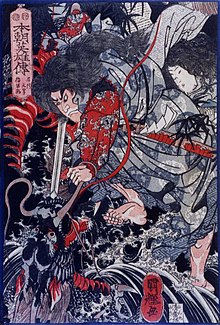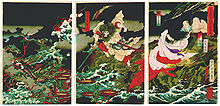Yamatanoorochi

Yamata no Orochi ( Japanese ヤ マ タ ノ オ ロ チ ; Kojiki : 八 岐 遠 呂 智 ; Nihonshoki : 八 岐 大蛇 ) is a dragon from the mythology of Shintō . According to the translation by Karl Florenz , his name means "eight-forked giant snake".
After his banishment from the heavenly realms ( Takamanohara ), Susanoo descended to Tori-kami and after some time met an old, weeping couple with a child between them on the river Hi. The old man introduced himself as the son of Ōyamatsumi , Ashinazuchi by name. His wife's name was Tenazuchi and the child was called Kushinadahime (in alternative versions of Nihonshoki, Kushinadahime was not yet born at this point).
When asked why she was grieving, Tenazuchi told Susanoo that he originally had eight daughters. But the eight-forked giant snake came every year and ate one of them. Now that the time had come for the snake to return, they would cry. To Susanoo's question about the shape, Ashinazuchi replies: “Her eyes are [red like] bubble cherries and on one body she has eight heads and eight tails. In addition, moss [( koke )] and cypress [( Hinoki )] and cryptomeria grow on their body . Its length extends over eight valleys and eight hills, and if you look at its belly, it is consistently bloody (and) inflamed everywhere. "
When Ashinazuchi promised to give him his daughter, Susanoo developed a ruse that he had the old couple prepare: He ordered them to brew eight- brewed sake , build a fence with eight gates, and tie eight raised frames together at each of the gates . A vessel with the eight times brewed sake should then be placed on each rack.
After Ashinazuchi and Tenazuchi had done so, the eight-pronged giant snake came, drank from all vessels with their heads and immediately fell into a deep sleep while drunk (in an alternative Nihonshoki version, Susanoo infuses the snake with the sake itself). Thereupon Susanoo slew the dragon with his ten hand's breadth sword (a tsurugi ) and thereby colored the hi red with blood. While chopping the middle tail, Susanoo knocked his sword into jagged edges and found the grass-mowing sword ( kusanagi-no-tachi , later one of the three throne insignia of Japan ).
The fight between Susanoos and Yamatanoorochi is an often discussed topic in Japanese mythology and is used in many Shinto shrines as an occasion for celebrations. Among the many interpretations, one says that the child's name Kushi (i) nadahime is an allusion to rice fields and the snake is the river Hi itself, so to understand its conquest by Susanoo as the use of wild nature for agricultural purposes. Another view, represented by Jean Herbert, is based on Yamatanoorochi as the personification of earthly powers, which Ashinazuchi and Tenazuchi, two heavenly kami, cannot defend themselves because they only use earthly powers. (This is based on their names, which mean "foot-caressing old man" and "hand-caressing old woman", which in Florence are an indication of their physical tenderness towards their child.) The number is also significant in an esoteric sense Eight , which reappears after this episode during the construction of the palace of Susanoo (in the Kojiki 50 times). The exact meaning of this number is, however, controversial and is usually translated as "a lot". Eight could e.g. B. be a symbol for perfection , infinity or holiness or refer to the cardinal points of the eight trigrams .
swell
- ↑ Karl Florenz: The historical sources of the Shinto religion . Vandenhoeck & Ruprecht, Göttingen and Leipzig 1919, p. 43.
- ↑ see footnote 4 in William George Aston : Nihongi. Chronicles of Japan from the Earliest Times to AD 697 . Tuttle Publishing, 2005, p. 52, ISBN 0-8048-3674-4
Web links
- Matsunaga Naomichi: "Yamatanoorochi" . In: Encyclopedia of Shinto. Kokugaku-in , May 13, 2005 (English)
